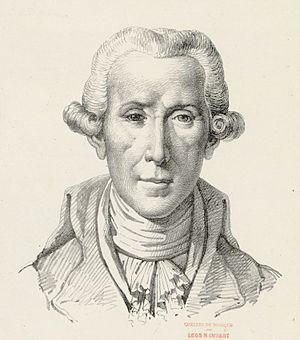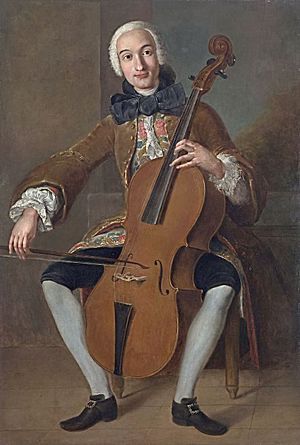Luigi Boccherini facts for kids
Luigi Boccherini (born February 19, 1743 – died May 28, 1805) was a famous Italian composer and cellist. He lived during the Classical music era. His music had a graceful and elegant style.
Boccherini is most known for a minuet from his String Quintet in E. He also wrote a well-known Cello Concerto in B flat major. For a long time, this concerto was played in a changed version. But now, musicians play its original version again.
Boccherini also wrote several pieces for the guitar. One of his guitar quintets ends with a lively Spanish dance called a fandango.
Contents
Luigi Boccherini's Life Story
Luigi Boccherini was born in 1743 in Lucca, Italy. His family was very musical. His father, Leopoldo Boccherini, was a cellist and double-bass player. Luigi's older brother, Giovanni, was a poet and dancer. He wrote stories for operas.
Luigi started learning the cello from his father at age five. When he was nine, he continued his music studies with Abbé Vanucci. He was the music director at a local church. At age thirteen, Luigi went to Rome to study with Giovanni Battista Costanzi.
In 1757, Luigi and his father moved to Vienna. They both worked as musicians in a theater there. In 1761, Boccherini went to Madrid, Spain. By 1770, he began working for Infante Luis Antonio of Spain. Luis was the younger brother of King Charles III of Spain.
Boccherini was very successful under Luis's support. But one day, the King did not like a part in one of Boccherini's new pieces. The King told him to change it. Boccherini was probably annoyed. Instead of changing it, he played the part twice as loud! This led to him being fired right away.
After that, Boccherini went with Don Luis to a small town called Arenas de San Pedro. He wrote many of his most famous works there.
Later, other important people supported Boccherini. These included the French ambassador to Spain, Lucien Bonaparte. King Friedrich Wilhelm II of Prussia also supported him. The King himself played the cello and flute.
Boccherini faced difficult times later in his life. His Spanish supporter, his two wives, and four of his daughters passed away. He died in Madrid in 1805. He had two sons who survived him. His body was buried in Madrid until 1927. Then, his remains were moved back to his hometown of Lucca, Italy.
What Music Did Boccherini Write?
Boccherini wrote a lot of chamber music. This is music for a small group of instruments. His music often followed the style of Joseph Haydn. However, Boccherini made the cello more important in his music. Haydn often used the cello only for background music. Boccherini's style was also influenced by another Italian cellist, Giovanni Battista Cirri. He also used ideas from Spanish folk music.
Boccherini was an amazing cello player. He could even play music written for the violin on his cello! He learned this skill when he filled in for sick violinists during tours. Other musicians praised his incredible control of the cello. You can hear this skill in the cello parts of his music. Especially in his quintets for two cellos. These often sound like cello concertos with a string quartet playing along.
He wrote many pieces for small groups of instruments. This includes over 100 string quintets. These quintets were for two violins, one viola, and two cellos. He was the first to write music for this combination of instruments. He also wrote about a dozen guitar quintets. Not all of them still exist today. He composed nearly 100 string quartets. He also wrote many string trios and sonatas, including at least 19 for the cello.
For orchestras, he wrote about 30 symphonies. He also wrote 12 difficult cello concertos.
A French musicologist named Yves Gérard created a list of all Boccherini's works. This list was published in 1969. That is why his works have "G" numbers, like G 275.
In 2006, the Italian government made all of Boccherini's works an "Italian National Edition." This means they are very important to Italy's culture.
Boccherini's music is known for being charming, light, and happy. It has many interesting melodies and rhythms. You can also hear influences from the guitar music of Spain, his adopted home.
Recordings of Boccherini's Music
- Complete Symphonies, Vol. I–VII, Deutsche Kammerakademie Neuss, Johannes Goritzki, CPO 999401-2
- Cello Concertos, Enrico Bronzi, Accademia I Filarmonici di Verona, Brilliant Classics 92618 (2005)
- Complete Flute Quintets, Vol. I–III, Rafael Ruibérriz de Torres, Francisco de Goya String Quartet, Brilliant Classics 96074 (2021)
- Guitar Quintets, Vol. I–III, Zoltán Tokos, Danubius String Quartet, Naxos 8.503255
- String Quintets, Vol. I–X, La Magnifica Comunita, Enrico Casazza, violin, Brilliant Classics 92503, 92889, 93076, 93346, 93566, 93820, 93744, 94002, 93977, 94961 (2005–2011)
Boccherini's music was also used in the 2003 movie Master and Commander: The Far Side of the World.
See also
 In Spanish: Luigi Boccherini para niños
In Spanish: Luigi Boccherini para niños
- Category:Compositions by Luigi Boccherini
- Romantic guitar
- Louis Picquot




